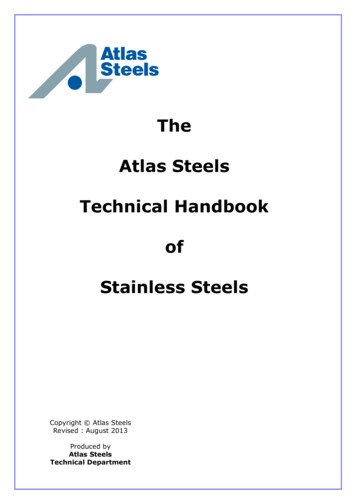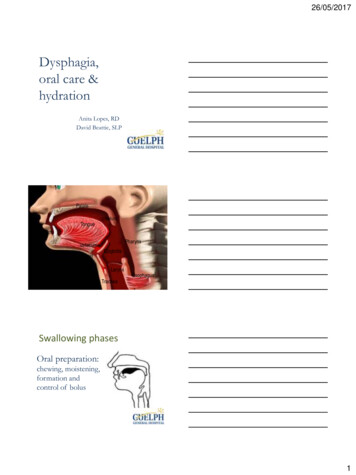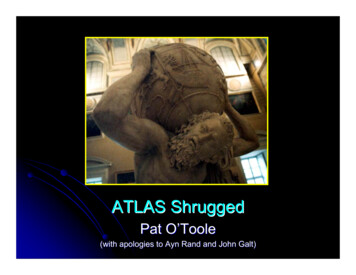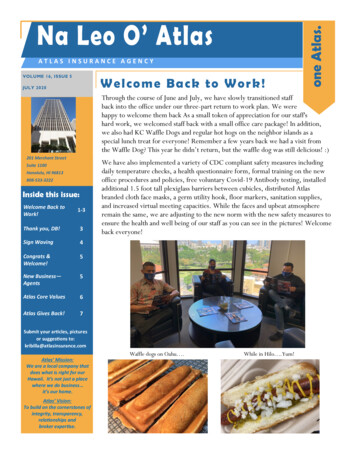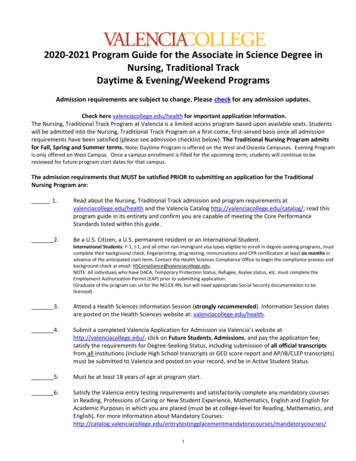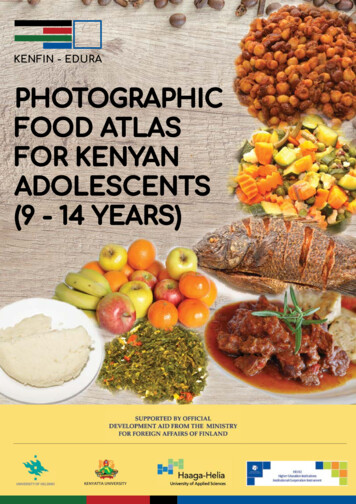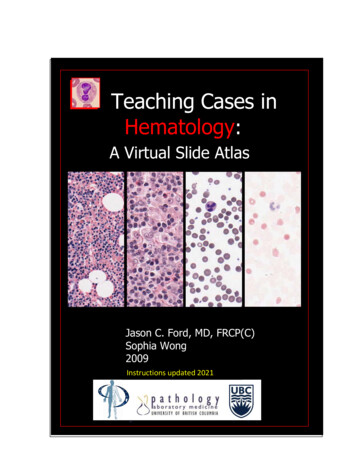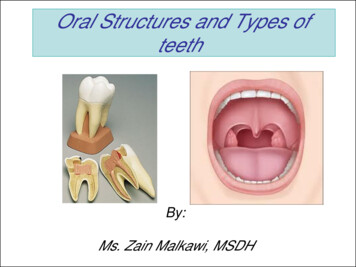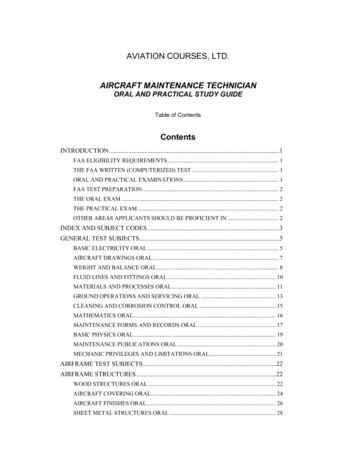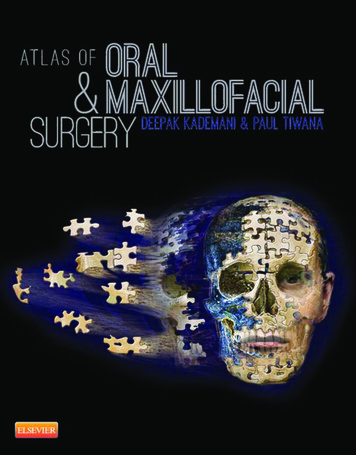
Transcription
ORAL& MAXILLOFACIALSURGERYATLAS OF
This page intentionally left blank
ORAL& MAXILLOFACIALSURGERYAtlas ofDEEPAK KADEMANI, DMD, MD, FACSChiefDepartment of Oral and Maxillofacial SurgeryFellowship DirectorOral/Head and Neck Oncologic and Reconstructive SurgeryNorth Memorial Hospital and Hubert Humphrey Cancer CenterMinneapolis, MinnesotaOral and Maxillofacial SurgeryUniversity of Minnesota Medical Center and Masonic Children’s HospitalMinneapolis, MinnesotaPAUL S. TIWANA, DDS, MD, MS, FACSAssociate ProfessorOral and Maxillofacial Surgery and Neurological SurgeryProgram DirectorOral and Maxillofacial SurgeryDepartment of SurgeryDivision of Oral and Maxillofacial SurgeryThe University of Texas Southwestern Medical SchoolParkland Memorial HospitalDallas, TexasDivision DirectorPediatric Oral and Maxillofacial SurgeryDepartment of SurgeryChildren’s Medical CenterDallas, Texas
3251 Riverport LaneSt. Louis, Missouri 63043ATLAS OF ORAL AND MAXILLOFACIAL SURGERYCopyright 2016 by Saunders, an imprint of Elsevier, Inc.ISBN: 978-1-4557-5328-4No part of this publication may be reproduced or transmitted in any form or by any means, electronic ormechanical, including photocopying, recording, or any information storage and retrieval system, withoutpermission in writing from the publisher. Details on how to seek permission, further information about thePublisher’s permissions policies, and our arrangements with organizations such as the Copyright ClearanceCenter and the Copyright Licensing Agency can be found on our website: www.elsevier.com/permissions.This book and the individual contributions contained in it are protected under copyright by the Publisher(other than as may be noted herein).NoticeKnowledge and best practice in this field are constantly changing. As new research and experiencebroaden our understanding, changes in research methods, professional practices, or medical treatment maybecome necessary.Practitioners and researchers must always rely on their own experience and knowledge in evaluating andusing any information, methods, compounds, or experiments described herein. In using such informationor methods, they should be mindful of their own safety and the safety of others, including parties forwhom they have a professional responsibility.With respect to any drug or pharmaceutical products identified, readers are advised to check the mostcurrent information provided (i) on procedures featured or (ii) by the manufacturer of each product to beadministered, to verify the recommended dose or formula, the method and duration of administration, andcontraindications. It is the responsibility of practitioners, relying on their own experience and knowledgeof their patients, to make diagnoses, to determine dosages and the best treatment for each individualpatient, and to take all appropriate safety precautions.To the fullest extent of the law, neither the Publisher nor the authors, contributors, or editors assumeany liability for any injury and/or damage to persons or property as a matter of product liability,negligence or otherwise, or from any use or operation of any methods, products, instructions, or ideascontained in the material herein.International Standard Book Number: 978-1-4557-5328-4Executive Content Strategist: Kathy FalkContent Development Manager: Jolynn GowerSenior Content Development Specialist: Brian LoehrPublishing Services Manager: Julie EddySenior Project Manager: Rich BarberDesigner: Amy BuxtonPrinted in ChinaLast digit is the print number: 987654321
This book is dedicated to the following individuals:Most importantly, to my wife, Rupam, who above all has made the greatest sacrificesin sharing my life as an academic surgeon. Thank you for raising our beautiful children,Jai (13), and Radha (11). For all your understanding, patience, and unconditional love,I am eternally grateful.My parents, Yeshwant and Lakshmi, for their love and for the sacrifices they made to allow meevery opportunity to pursue my education. My sister, Preet, for her love and support.To all those who have invested in my education and career. My academic and surgical mentors,Peter Quinn, David Stanton, Lawrence Levin, Raymond Fonesca, John Mooney, Joseph Foote,Barry Hendler, Leon Assael, Eric Dierks, and Bryce Potter—thank you for being so generous.I am deeply indebted to my great friend and co-editor, Paul Tiwana, for his hard work anddedication in meeting the greatest challenge of developing this book. To our section editors,authors, and artists, without whom this book would not have been possible.To all my former, current, and future residents and fellows—thank you for inspiring me. I hopeyou will use this Atlas to establish the foundation of your operative knowledge.Deepak KademaniThis book is dedicated to the following individuals:To the surgeons who mentored and trained me:Mark F. Erickson, Gene Sbalchiero, Timothy A. Turvey, John R. Zuniga, Raymond P. White,George H. Blakey III, Dennis G. Hillenbrand, Ramon L. Ruiz, Jeffrey C. Posnick, Gerald D.Verdi, Brian Alpert, Douglas P. Sinn, and Robert V. Walker.They have given so much of themselves to my education and my professional life. Thank you.To my great friend and colleague, Deepak Kademani, who enthusiastically embarked with meon this journey with vision and perseverance.To our section editors, authors, and medical illustrators, without whom this text would not havebeen possible. Thank you for your hard work and dedication.To my current and former residents, who inspire me every day to be the best surgeon I can beand remind me of my true calling: to be a teacher of surgeons.To my father, Gurdev, and my mother, Balbir. They sacrificed so much to put the education oftheir children first. Teachers themselves, they fostered in me a passion for my education, theself-discipline needed for achievement, and the courage to follow my dreams. Also to my brotherand sister, Dave and Karen. Thank you all for your understanding, support, encouragement,and love.Most important, to my wife, Karen, and our two beautiful daughters, Jespreet (10) and Simran(8). They, above all, have borne the cost of an academic surgeon’s life. Thank you for sharing mewith both my patients and my specialty. Your constant support and unconditional love forms mybedrock, gives the compass of my life direction, and is a beacon that draws me home wherever inthe world I happen to be.Paul Tiwana
The diagnosis and management of benign pathology of the oral/head and neck region is athought-provoking and formidable discipline in our specialty. In many respects, these exercisesremain at the core of oral and maxillofacial surgery practice. I thank the authors of the chapterscontained within, therefore, for their contributions on the scientific background and techniquesassociated with the extirpation of benign entities of the jaws, neck, salivary glands, thyroid, andparathyroid glands. With the direction provided by Deepak Kademani and Paul Tiwana, thedevelopment of this project has been a very gratifying experience.Eric R. CarlsonHuman anatomy does not change over time, but surgical approaches and techniques certainly do.The Kademani-Tiwana “K-T” Atlas will quickly become a classic and will be regarded by futuregenerations of surgeons of multiple disciplines as a cornerstone of their learning. The scope of thisAtlas is reflective of the scope of modern American oral and maxillofacial surgery, which hasevolved into better alignment with that of the rest of the world.I would like to dedicate my modest contribution to this noble effort to my wife, Barbara; our son,Gregor; and my daughter, Louise. Each has sacrificed, either knowingly or not, and theirforbearance over the years regarding the time consumed by my academic endeavors is deeplyappreciated and can never be adequately compensated.Eric DierksI would like to thank Elsevier and Deepak Kademani and Paul Tiwana for allowing me toparticipate in this wonderful project as a section editor. I also would like to thank the authorswho have contributed to the cosmetic surgery section of this great Atlas, which will be a tremendous edition to our specialty. Students, residents, and faculty will be able to benefit from it formany years to come. Congratulations to everyone involved in this project.Tirbod FattahiI would like to dedicate my small portion of this text to my mentors, Dr. Robert V. Walker, Dr.William H. Bell, and Dr. Douglas P. Sinn—they opened all the doors! Personally, I dedicate thisto the loves of my life, Judy and Richard II.Richard FinnThe depth and completeness of this Atlas provides the reader a contemporary guide to theprocedures undertaken in any leading-edge oral and maxillofacial surgery training program.I would like to extend my appreciation to the authors and section editors for their invaluablecontributions to this work. In particular, I commend Drs. Kademani and Tiwana for thisambitious and monumental project that will most definitely appeal to a wide readership, inmultiple surgical specialties, which will forever be captivated by this surgical Atlas. Finallyand most importantly, I wish to extend my thanks and love to my wife Hope and ourwonderful children, Gregor, Gracie, Gabrielle, and Garrisyn for their understanding andeternal support.G.E. GhaliI would like to thank all of the authors for their tireless effort in contributing to the creation ofthis important work. They have shared their expertise and dedicated their effort to producea reconstructive oral and maxillofacial surgery Atlas that is current and will be a great resourcefor years to come. Their contributions will help improve the life of others by their skills and theirdedication to surgery. I would also like to thank Dr. Deepak Kademani and Dr. Paul Tiwanafor their vision for this challenging yet rewarding endeavor.My wife, Kiralina, deserves special thanks for her endless support and encouragement for me topursue my dreams in Oral and Maxillofacial Surgery while raising our four beautiful children.Thanks to my amazing children, Gavin, Zoe, Sadie, and Austin, for their love which providesthe balance that allows me to have a wonderful life.Alan Herford
To all of the OMS residents who inspire and challenge me every day.Pamela HughesIt has been an honor to oversee and edit this section on orthognathic and craniofacial surgery.Just when we think we have matured in this arena of surgery, we continue to see excitingdevelopments–from planning our surgery with the use of virtual technology, to a more clearunderstanding of outcomes and the stability of our results. Most surgical procedures have changedlittle, but planning, execution, and stabilization have advanced to a higher level of predictability. This section incorporates all the changes in this surgical arena as well as providing theinsight of experienced surgeons in diagnosis, timing of intervention, procedural technique,stabilization, and projected outcomes and expectations. The readers’ take-away information willguide their thoughts and surgical outcomes. This is a win/win for both patients and theirsurgeons.As this effort concludes on the Atlas by Paul Tiwana and Deepak Kademani, I feel it will be avaluable contribution to our specialty, to the volume of knowledge of our surgeons, and ultimately to patients. For more than 40 years, it has been personally rewarding to be involved inthe development of surgical technique, and this effort was completed with affection for mypatients and my dedication to OMS. I am, as always, grateful for the guidance of my mentor,Dr. Robert V. Walker, the support of my family, and the loving encouragement of my wife,Diane.Douglas P. SinnI would like to offer my sincere thanks to Deepak Kademani and Paul Tiwana for the opportunity to contribute to their seminal Atlas. The content is sophisticated, yet it is presented clearlythrough an incredible number of meticulously rendered brand-new medical illustrations. Iappreciate the effort each of my section authors put in to produce their high-quality chapters,presenting the boundaries we push at in the arena of dental implants. Personally, I would like tothank my wife, Michelle, for her insight, patience with my schedule, and her unending support ofour endeavors.Martin B. SteedReconstructive oral and maxillofacial surgery has experienced significant advances in the recentpast, particularly with the addition of microvascular surgical techniques. I would like to thankall the authors for the comprehensive nature of their chapters in grafting techniques, axial flaps,and free tissue transfer, which I expect to be utilized by residents, fellows, and practicingsurgeons in the years and decades to come. My thanks to Deepak Kademani and Paul Tiwanafor inspiring and seeing this project through. Nothing I do in life comes without my heartfeltthanks to my wife, Jana, and our children, McKinlee, Tanner, Connor, Whitney, Parker, andCarter for their never-ending support.Brent WardSurgery for temporomandibular joint disorders has been, and always should be, within theconfines of oral and maxillofacial surgery. It has been an honor and a privilege to have learnedfrom some of the best surgeons as a young resident, and it continues to be an honor and aprivilege to work with the authors in the section on TMJ surgery, who continue to teach andevolve the field of TMJ surgery. Together, we hope to pass on our experiences to the nextgeneration of TMJ surgeons. It is our patients and the future generation of patients who willbenefit by the efforts and skills illustrated by the authors. Oral and maxillofacial surgeons shouldlook to no one but themselves to provide the treatment and care for TMJ disorders now and inthe future. My thanks to Deepak Kademani and Paul Tiwana for providing us the opportunityto make these contributions and their hard work to complete the task of organizing and producing a great Atlas.John Zuniga
PrefaceThe first printed atlases were editions of the text of ClaudiusPtolemy, an Alexandrian geographer working circa 150 AD.These were illustrated with a set of 27 maps constructed fromPtolemy’s calculations. From this first collection, the conceptof the atlas was developed: a bound collection of maps covering the current knowledge of a specific geographic region orworld. We initially developed this atlas independently withElsevier. The similarities in our individual concepts led us tocombine our efforts in producing this book. Like Ptolemy, wehave aimed our collaborative efforts to produce a landmarkpublication to define the world of our specialty.Significant geographic differences in the scope of surgicalpractice from one country to another continue to exist in oraland maxillofacial surgery. These differences often are basedon local educational requirements and training standards.Much of the evolution of our specialty is also balanced withthe development of complementary specialties in otorhinolaryngology, head and neck surgery, and plastic and reconstructive surgery. Although our foundations are intimatelyassociated with a comprehensive understanding of oral andcraniomaxillofacial disease and function and are based indentistry, the specialty of oral and maxillofacial surgery hasevolved to include both a medical and a dental basis of training. This early and comprehensive focus on oral and craniomaxillofacial disease and function creates several distinctadvantages: first, a body of knowledge for dealing with thestructural anatomy and function of the oral and craniomaxillofacial complex; second, an in-depth familiarity with histopathology and the progression of diseases of the head andneck; and third, an emphasis on the importance of precisesurgical reconstruction to ensure that the demands of oraland facial function are met. This atlas was written to takeadvantage of these unifying strengths of our specialty. Itprovides a navigational aid that can guide both experiencedviiisurgeons and surgeons in training through new operationsand provide a basis for refinements of already establishedoperations in their repertoire. Each chapter is organized in asimilar fashion, guiding surgeons through the complexanatomy, instrumentation, technical operative surgery, andmodifications. Our aim is that this Atlas will define andcapture the global perspective of oral and maxillofacialsurgery.Within the past few decades, we have seen the specialtyof oral and maxillofacial surgery grow and expand. Althoughmany books cover this expanded practice of the discipline,we observed that a comprehensive and detailed atlas coveringoperative technique was absent in the literature. This bookis written to provide practicing surgeons, residents, and students the most up-to-date reference for the technical performance and reasoning behind the many types of operationsused in our specialty. From the basic to the most complex,readers will find that each chapter is sequentially organizedto provide a comprehensive, concise, and practical descriptionof the operative details needed for contemporary surgicaldelivery of oral and maxillofacial surgery. A formal sectionon relevant surgical anatomy has been incorporated to furtherassist the reader. This section is a new idea in a surgicaltext, and we believe it will enhance the value of this Atlas.Each chapter has been written by an expert surgeon andauthor who has a specific area of expertise. We would like toexpress our gratitude to all the section editors and authorsfor lending their time and expertise to the development ofthis Atlas.It is our hope that the information presented here willform the basis of defining the scope of practice of oral andmaxillofacial surgery and will provide a basis for educationand training for surgeons in the future, with the ultimate goalof improving the quality of patient care across the world.
ForewordWhen Paul Tiwana requested a foreword to accompany theAtlas of Oral and Maxillofacial Surgery, I was glad to accommodate him. Paul is not just a dedicated and skilled surgeon,but also an educator who has made research contributions tothe field. Early on, Paul developed an interest in the surgicalmanagement of cleft and craniofacial malformations. Hisresidency training was followed by a formal fellowship inpediatric craniofacial surgery under my direction in Washington, DC, and he now serves as graduate program director,Division of Oral and Maxillofacial Surgery, at the Universityof Texas Southwestern Medical Center in Dallas. His clinicalpractice includes the management of cleft and craniofacialanomalies.Tiwana’s and Kademani’s intention in the writing andediting of this atlas is to define and capture the global perspective of oral and maxillofacial surgery. Although the education, training, and scope of practice of the specialty varywidely from country to country, the future direction of oraland maxillofacial surgery should be clear. This atlas serves asa beacon by which the specialty can navigate as it continuesto define itself.The atlas is divided into 11 sections with specific surgicalprocedures. Dividing the atlas into these 11 sections makessense, based on surgical anatomy and disease considerations.Each section editor was well selected by Paul and Deepak forhis or her expertise and past scientific contributions. Thedetailed surgical procedures covered in the atlas are relevantand, as a group, are comprehensive for the practice of oraland maxillofacial surgery.An atlas of this depth and breadth rightfully requires thecontributions of many authors from around the world. Thetask of the editors and publisher is to establish and thendemand a consistent, readable format; high-quality contributions by each author; and then meticulous editing to avoidthe repetition so commonly seen in texts with multipleauthors. By definition, an atlas also must have consistentlyhigh-quality and accurate illustrations. This atlas achieves allof these objectives, which is a tribute to the joint efforts ofeach and every author, the illustrator, the editors, and thepublisher.Through the Atlas of Oral and Maxillofacial Surgery, Pauland Deepak have made a significant contribution to thespecialty and, more important, to the care of children andadults with craniofacial and maxillofacial deformities of allkinds.Jeffrey C. Posnick, DMD, MD, FRCS, (C), FACSDirector, Posnick Center for Facial Plastic SurgeryClinical Professor of Surgery and PediatricsGeorgetown University, Washington, DCClinical Professor of OrthodonticsUniversity of Maryland, School of DentistryBaltimore, MarylandAdjunct Professor of Oral and Maxillofacial SurgeryHoward University College of Dentistry, Washington, DCix
ForewordTwo widely recognized, midcareer, academic oral and maxillofacial surgeons independently approached Elsevier severalyears ago with remarkably similar proposals for book projects.Each of these well-established leaders was the product of acontemporary advanced training pathway that was not available in the specialty of oral and maxillofacial surgery duringthe era of Fred Henny and R.V. Walker—fellowships. Theseaspiring authors had each completed fellowships with different foci: Paul Tiwana in craniofacial surgery and DeepakKademani in head and neck oncologic surgery. The directorsof each of their fellowships were themselves the products ofdual training: Posnick in oral and maxillofacial surgery(OMFS) in addition to plastic surgery, and myself in oral andmaxillofacial surgery as well as otolaryngology. Kathy Falkand John Dolan at Elsevier quickly saw the wisdom of combining the talents of Tiwana and Kademani. Once united, theco-editors assembled a core group of 11 section editors, whorepresent acknowledged subspecialty experts in AmericanOMFS. They reviewed multiple proposals from medical illustrators and immediately grasped the talent of Joe Chovan asthe artist to uniquely convey the visual message that definesan outstanding surgical atlas and that differentiates the bestxfrom the rest. The result—this book—will come to be recognized as the definitive surgical atlas of the OMFS specialtyand will have broad appeal to other specialties.This Atlas represents the contributions of many thoughtleaders of our specialty, often in collaboration with younger,rising academic stars. This work will serve as a resource tomany and at multiple levels. To OMFS residents in training,it will provide a fecund seed for the development of theirsurgical fund of knowledge. To fellows in OMFS and otherrelated disciplines, this atlas will help refine their skills andperhaps stimulate their own future contributions. Contemporary broad-scope practitioners will readily find a place ontheir shelves for this thorough reference. It is a distinct pleasure to have been involved in the creation of this atlas.Eric Dierks, DMD, MD, FACSAffiliate ProfessorDirector, Associated Fellowship Program in Head and NeckOncologic SurgeryOral and Maxillofacial SurgeryOregon Health & Science UniversityPortland, Oregon
AcknowledgmentsWe are deeply grateful to our many friends and colleagueswho have supported us and contributed to this book. Inparticular we wish to thank our section editors—Eric Carlson,Eric Dierks, Alan Herford, Tirbod Fattahi, Ghali Ghali,Martin Steed, Doulas Sinn, Richard Finn, Pamela Hughes,Brent Ward, and John Zuniga—who worked tirelessly tocomplete their editorial efforts. We thank them immenselyfor their confidence and support in bringing this project tofruition.We are also indebted to the many authors who gave theirtime and expertise in contributing to this book to make it areality. The editorial process was far easier because of thehigh-quality, timely submissions by all the authors. We owea particular debt of gratitude to our primary artist on thisproject, Joe Chovan. His artistic interpretation of surgicalprocedures was simply breathtaking. We also would like toacknowledge the artistic contributions of Devon Stuart andMary Kate Wright.Finally, we would like to thank the editorial team at Elsevier for supporting our collective vision in developing thisproject. In particular we would like to thank Brian Loehr forthe management of this project from its inception, KathyFalk for her support and confidence in guiding the development of this Atlas, and John Dolan, who shared the vision,with Kathy, to put us together to make the Atlas a reality.Deepak KademaniPaul Tiwanaxi
Section EditorsEric R. Carlson, DMD, MD, FACSProfessor and Kelly L. Krahwinkel ChairmanDepartment of Oral and Maxillofacial SurgeryDirector of Oral and Maxillofacial Surgery ResidencyProgramUniversity of Tennessee Graduate School of MedicineDirector of Oral/Head and Neck Oncologic SurgeryFellowship ProgramUniversity of Tennessee Cancer InstituteKnoxville, TennesseeEric Dierks, MD, DMD, FASCAffiliate Professor of Oral and Maxillofacial SurgeryOregon Health & Science UniversityDirector of Fellowship in Head and Neck Oncologic andMicrovascular Reconstructive SurgeryHead and Neck Surgical InstitutePortland, OregonTirbod Fattahi, MD, DDS, FACSAssociate Professor, ChairDepartment of Oral and Maxillofacial SurgeryCollege of MedicineUniversity of FloridaJacksonville, FloridaRichard A. Finn, DDSProfessorDepartment of SurgeryDivision of Oral and Maxillofacial SurgeryProfessorDepartment of Cell BiologyUniversity of Texas Southwestern Medical CenterChief, Oral and Maxillofacial SurgeryVeteran’s Administration North Texas Health Care SystemsDallas, TexasGhali Ghali, DDS, MD, FACSGamble Professor and ChairmanOral and Maxillofacial SurgeryHead and Neck SurgeryLouisiana State University School of MedicineShreveport, LouisianaxiiAlan S. Herford, DDS, MD, FACSProfessor, ChairDepartment of Oral and Maxillofacial SurgeryLoma Linda UniversityLoma Linda, CaliforniaPamela J. Hughes, DDSAssociate Professor and ChairDepartment of Oral and Maxillofacial SurgeryOregon Health & Science UniversityPortland, OregonDouglas P. Sinn, DDS, FACDClinical Professor and Past ChairDivision of Oral and Maxillofacial SurgeryUniversity of Texas Southwestern/Parkland HospitalDallas, TexasMartin B. Steed, DDSAssociate Professor and ChairDepartment of Oral and Maxillofacial SurgeryMedical University of South CarolinaJames B. Edwards College of Dental MedicineCharleston, South CarolinaBrent B. Ward, DDS, MDAssociate Professor and Program DirectorOral/Head and Neck Oncology and MicrovascularReconstructive SurgeryOral and Maxillofacial SurgeryUniversity of MichiganAnn Arbor, MichiganJohn Zuniga, DMD, MS, PhDRobert V. Walker DDS Chair in Oral and MaxillofacialSurgeryProfessorDepartment of SurgeryUniversity of Texas SouthwesternDallas, Texas
ContributorsA. Omar Abubaker, DMD, PhDProfessor, ChairmanDepartment of Oral and Maxillofacial SurgeryVirginia Commonwealth UniversityRichmond, VirginiaJulio Acero, MD, DMD, FDSRCS, FEBOMFSAssociate ProfessorHead Department of Oral and Maxillofacial SurgeryRamon y Cajal-Puerta de Hierro University HospitalsUniversity of AlcalaMadrid, SpainRavi Agarwal, DDSProgram DirectorDepartment of Oral and Maxillofacial SurgeryWashington Hospital CenterWashington, DCTara Aghaloo, DDS, MD, PhDProfessorSection of Oral and Maxillofacial SurgeryAssistant Dean for Clinical ResearchSchool of DentistryUniversity of California, Los AngelesLos Angeles, CaliforniaKyle P. Allen, MD, MPHTampa Bay Hearing and Balance CenterTampa, FloridaDror M. Allon, DMDProgram DirectorOral and Maxillofacial SurgeryRabin Medical CenterSackler School of MedicineTel Aviv UniversityTel Aviv, IsraelBrian Alpert, DDS, FACD, FICDChairman, ProfessorOral and Maxillofacial SurgeryDepartment of Surgical and Hospital DentistryUniversity of Louisville School of DentistryLouisville, KentuckyChiefDepartment of Oral and Maxillofacial Surgery andDentistryUniversity of Louisville HospitalLouisville, KentuckyMehmet Ali Altay, DDS, PhDDoctor of Oral and Maxillofacial SurgeryFaculty of DentistryAkdeniz UniversityAntalya, TurkeyResearch FellowDepartment of Oral and Maxillofacial SurgerySchool of Dental MedicineCase Western Reserve UniversityCleveland, OhioJoan Pi-Anfruns, DMDAssistant Clinical ProfessorSections of Oral and Maxillofacial Surgery/RestorativeDentistryDivisions of Diagnostic and Surgical Sciences/Constitutiveand Regenerative SciencesSchool of DentistryUniversity of California, Los AngelesLos Angeles, CaliforniaShyam Prasad Aravindaksha, BDS, MDSAssistant ProfessorDepartment of Oral and Maxillofacial SurgeryUniversity of Detroit MercySchool of DentistryDetroit, MichiganSharon Aronovich, DMDClinical Assistant ProfessorAssistant Program DirectorDepartment of Oral and Maxillofacial SurgeryUniversity of Michigan Health SystemAnn Arbor, MichiganLeon Assael, DMDDeanProfessor of Oral and Maxillofacial SurgerySchool of DentistryUniversity of MinnesotaMinneapolis, Minnesotaxiii
xivContributorsShahid R. Aziz, DMD, MD, FACSProfessorDepartment of Oral and Maxillofacial SurgeryRutgers University School of Dental MedicineNewark, New JerseyDental DirectorLittle Falls Dental CenterLittle Falls, New JerseyPresident and Co-FounderSmiles BangladeshMountainside, New JerseyShahrokh C. Bagheri, DMD, MD, FACS, FICDChiefDivision of Oral and Maxillofacial SurgeryDepartment of SurgeryNorthside HospitalGeorgia Oral and Facial Reconstructive SurgeryAtlanta, GeorgiaClinical Associate ProfessorDepartment of Oral and Maxillofacial SurgeryGeorgia Health Sciences UniversityAugusta, GeorgiaClinical Assistant ProfessorDepartment of SurgerySchool of MedicineEmory UniversityAtlanta, GeorgiaJonathan Bailey, DMD, MD, FACSClinical Associate ProfessorResidency Program DirectorAssociate Medical Director Specialty Surgery ServicesDivision of Oral and Maxillofacial SurgeryDivision of Head and Neck CancerCarle Foundation HospitalUrbana, IllinoisConor Barry, FRCS (OMFS), MFD (RCSI)Clinical Fellow in Head and Neck Cancer SurgeryQueen Elizabeth HospitalBirmingham, United KingdomBrian Bast, DMD, MDResidency Program DirectorProfessor and Interim ChairDepartment of Oral and Maxillofacial Surgery
Atlas is reflective of the scope of modern American oral and maxillofacial surgery, which has evolved into better alignment with that of the rest of the world. I would like to dedicate my modest contri
